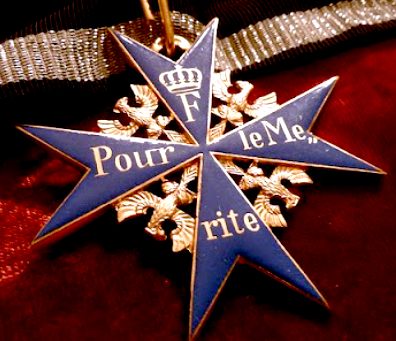|
THE BLUE MAX MEDAL
|
|
|
A BRIEF HISTORY OF THE POUR LE MERITE ( THE BLUE MAX).
AIRCRAFT
U BOATS
During the same conflict, the medal was also awarded to U Boat captains who had sunk 190,000 tons of enemy shipping. Such an award was made to Kapitan-Leutnant Walther Schwieger,
THE OAKLEAVES:
NOTABLE RECIPIENTS
Notable recipients included Field Marshal Leonhard Graf von Blumenthal, Manfred von Richthofen, better known as the "Red Baron", Hermann Göring, who later became one of the most senior leaders of the Third Reich, Erwin Rommel, the famed "Desert Fox" of WWII, Kress von Kressenstein, and Paul von Lettow-Vorbeck , who led German forces in the guerrilla campaign in German East Africa. The last living holder of the Pour le Mérite was novelist Ernst Jünger, who died in 1998.
Although many of its most famous recipients were junior officers, especially pilots, more than a third of all awards went to generals and admirals. Junior officers (army captains and lieutenants and their navy equivalents) accounted for only about 25% of all awards. Senior officer awards tended to be more for outstanding leadership in combat than for individual acts of bravery.
The award was abolished with Kaiser Wilhelm II's abdication on 9 November 1918.
In 1952, the President of West Germany, Theodor Heuss, revived the peace class of the order as an autonomous organization under the protection of the German President (although it is not a state order like the Bundesverdienstkreuz). This revised order is awarded for achievements in the arts and sciences, rather than for military merit. Laureates of the present are e.g. Wim Wenders (filmmaker), Rudolf Mößbauer (physicist and Nobel Prize winner) and Umberto Eco (writer).
MORE DETAILS
Although it may sound incongruous Germany's highest military medal awarded during World War One was the decidedly French sounding Pour le Merite (also known the as 'The Blue Max').
The award dates back to 1667 when, in the German state of Brandenburg, the Ordre de la Generosite - the Order of Generosity - was created by Frederick William I. Given that French was the language of the royal court the naming of the merit award would have appeared a natural choice.
The award's name was subsequently modified in June 1740 to Pour le Merite by Frederick the Great. Frederick planned to issue the new award to subjects performing with particular merit in the coming conflict with Silesia.
Until January 1810 the award could (and was) awarded to civilians in additional to military personnel. Frederick William III however decreed that henceforth the award could only be presented to serving military personnel, although a civil class for arts and science was initiated in 1842.
Following the death of his wife, Queen Louise, Frederick determined to create the 'Oakleaves' in her honour. The Oakleaves (which was formally documented in 1813) was available for presentation to Pour le Merite holders in the event of additional extraordinary achievements.
The Pour le Merite, along with all other imperial orders, was similarly abolished along with Kaiser Wilhelm II's abdication on 9 November 1918. Once again however a civil class of the award was re-introduced in February 1922.
Curiously, receipt of the Pour le Merite need not only be a once-only honour. Some recipients were awarded the medal on two and even three separate occasions - although on the other hand the unfortunate Count Franz Florentin Valory received his award some 21 years after the events actually cited.
During the Great War of 1914-18 the award gained its greatest fame. It was awarded to commanders operating on all fronts and in all forms of warfare. In the aerial war a fighter pilot was initially entitled to the award upon downing eight enemy aircraft. Max Immelmann was thus the first airman to receive the award, after which it became known - on account of its colour and its recipient - as the Blue Max among his fellow pilots.
The qualifying total was subsequently revised to 16. Although the Red Baron, Manfred von Richthofen, readily qualified for the award he was not however - and to Erich Ludendorff's surprise - awarded the supplementary Oakleaves. The last surviving recipient of the military Pour le Merite - Ernst Junger - died in 1998.
LINKS
http://www.pourlemerite.org/
TRIVIA
A movie was made about the exploits of the Red Baron, named after the famous medal, starring George Peppard and James Mason: The Blue Max.
Stirrings in the Amazon jungle send alarm bells ringing for John Storm and his intrepid crew.
|
|
|
This
website is copyright © 1991- 2014 Max Energy Ltd. All rights
reserved. The bird logo |

